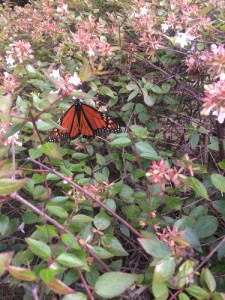Danaus plexippus, the monarch butterfly, is a well known species of butterfly through out the United States. I didn’t intend on using this species this week. Originally, I wanted to use a pine species from the Livingston area where the Texas chapter of the Society for Ecological Restoration was holding their conference this year. An undergraduate group had studied seed germination of 3 species of milkweed native to Texas, I only knew of the common milkweed so I decided to look familiarize myself with with the Asclepias genus and was surprised by the diversity. Since monarch butterflies rely on milkweed in their life cycle, I thought I could use an earlier observation to discuss the biodiversity of milkweed without an observation.
I saw this monarch on campus and took a picture with iNaturalist for my own personal record . These butterflies are pollen generalists but only lay their eggs in milkweed to provide food for the caterpillars, their larval stage. There are over 30 types (Asclepias spp.) of native milkweed found in Texas and the unique obligatory relationship between the monarch butterfly and milkweed is a great example of co-evolution. A lot of effort has been put into restoring the butterfly population in the last few years and a major agencies like the USDA have been educating the public about saving populations of milkweed and implementing them in to gardening practices. Antelopehorns (Asclepias asperula) is found in the Blackland prairies and Edwards Plateau, so it possibly could have been observed in the areas surrounding Austin. Many of the milkweed species look similar but their unique inflorescence are helpful in the identification process.
Information about Asclepias spp. can be found here
iNaturalist post can be found here
